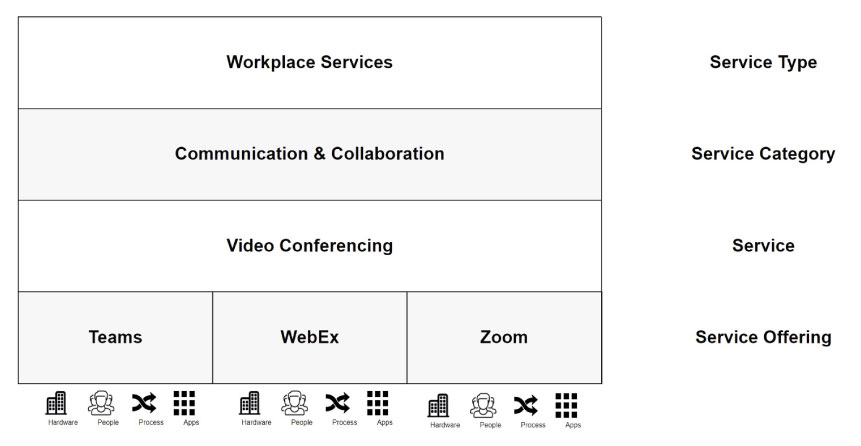
While there may be some in your organization who fully understand what Technology Business Management (TBM) is, many may not. Additionally, some may not understand what challenges taxonomy solve and different business teams may not use the same language to discuss TBM. A TBM taxonomy helps unify the language used and disparate tools used while also helping to identify areas of opportunity.
What is TBM Taxonomy?
TBM Taxonomy is a framework that builds a bridge between finance and technology leaders using terminologies that everyone understands. The accepted definition is held by the TBM Council which was founded in 2012 with the goal to focus “on improving business outcomes by giving technology, finance, and business leaders a consistent way to translate technology investments to business value through Education, Standards, and Collaboration.”
Advantages to TBM Taxonomy
There are a number of common problems that can be solved by this IT management framework. While working with clients to help them create a taxonomy we have observed a few improvements influenced by adopting this practice.
Improvements include,
- Acceleration of implementations of TBM models and software
- Aligns data from multiple tools (PPM, Agile, CMDB, SAM, ITSM)
- Aligns people with common vocabulary
- Relates different perspectives (finance, IT/tech and line-of-business)
- Influences industry adoption of TBM principles, best practices, and tools

When is the Best Time to Adopt TBM Taxonomy Practices?
The short answer to this is, as soon as necessary. A small organization may not need to adopt a formal framework, but enterprise level organizations will greatly benefit from adopting the TBM framework. Most evolve into implementing using a TBM framework when they first start using a new PPM tool like Apptio or when they want to expand their service portfolio. Some larger organizations employ the use of a TBM analyst to help maintain their TBM cost model.
Services (Tiers) Defined
A Service is defined by the IT Infrastructure Library (ITIL) as a service that delivers value by enabling outcomes that users or business functions want to achieve without owning specific costs or risks.
The Characteristics of Services include,
- They are architected from the reference model and contain business system or technology capabilities.
- They are comprised of offerings consumed by a Business Function, User, Partner, or another IT Organization (the business can request them).
- It is managed through its lifecycle by a Service Manager (Owner)
- It is organization agnostic.
- It is defined in terms that resonate with the consumer, not the provider.
Types of Services are Organized by Tiers,
Tier A: Internal IT Services for example, technical services such as hosting, security, and storage.
Tier B: Business Aligned Services that are arranged in two groups, Commodity Services needed to run the business and Competitive Advantage Services to help the business be competitive.
Tier C: End User Aligned are services used by employees which are measured by user experience and cost.
The services themselves are organized by Service Type, Service Category, Service, and Service Offering.

Service Approaches or Perspectives
When defining Approaches or Perspectives, views are divided into four groups.
- Activity View: Things the organization does, what you do, and what you offer.
- Architecture View: The connection of processes, systems, and technologies.
- Organizational View: How IT is organized.
- Financial View: How financial systems distribute budget to organization.

Standard Cost Models
Cost models are organized into four groups and three views.
- Showback and Charge Back (Business View): Assets or Services purchased charge to the department or visible to finance.
- Business Services (IT View): Assets or Services purchased using terms and groupings relevant to both IT and Finance.
- Technical Services (IT View): Assets or Services purchased using terms and groupings relevant to both IT and Finance.
- Cost Pools (Finance View): Assets or Services purchased using terms and groupings relevant to both IT and Finance.

Business Services Defined
An example of how Business Services may be further defined,

Total Cost of Ownership (TCO)
In this example, we have outlined associated costs for email services. Related costs go far beyond simply the email services, it also includes supporting services such as security, backup and restore services, network support, and exchange management resources. Utilizing the TBM Framework, you can more easily account for the TCO for each service including human resources.

Who Uses the TBM Taxonomy?
The TBM Taxonomy is used by finance, business, and technology leaders. The taxonomy helps leaders communicate using terms that they all understand. The taxonomy is governed by the TBM Council Board Committee on Standards. The three main views include Business, IT, and Financial.
Commonly, these roles utilize the TBM Taxonomy:
- TBM Program Professionals: To build and maintain a TBM cost model based on defined standards.
- IT Financial Managers: To support technology cost modeling and reporting.
- CIOs and I and O Leaders: For receiving information about composition and drivers of technology costs.
- Enterprise Architects: As these roles are interested in service composition, consumption, and costs.
- CFOs and their teams: To deal with business unit cost allocations, chargebacks, and budget authority for tech spending.
- Owners: Owners of services (DevOps), apps, and other solutions who are accountable for Total Cost of Ownership (TCO).

The TBM Taxonomy Overview
There are many parts to the TBM Taxonomy, which is often best expressed using a visual or chart like the one created by the Technology Business Management Council.
The major tools of the TBM include,
- Business Units: Business Units, Business Architecture, and Customers and Partners.
- Solutions: The Applications, Products, and Services used by business units and programs.
- Towers: The technology functions supported.
- Cost Pools: The types of assets, services or resources purchased.

Tools of TBM Taxonomy

To learn more about how to facilitate engagement and align leadership, see TBM Transformation Journey Map.
Rego Can Help
Need more help with Technology Business Management in your organization? Contact us for a no-pressure conversation. We’re happy to help.
We’ve guided more than 650 organizations through their FinOps, TBM, PPM, and Agile journeys, including 60% of Fortune 100 companies.

- What is TBM Taxonomy?
- Advantages to TBM Taxonomy
- When is the Best Time to Adopt TBM Taxonomy Practices?
- Services (Tiers) Defined
- Service Approaches or Perspectives
- Standard Cost Models
- Business Services Defined
- Total Cost of Ownership (TCO)
- Who Uses the TBM Taxonomy?
- The TBM Taxonomy Overview
- Rego Can Help
- About the Author: Rego Consulting










